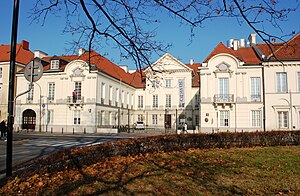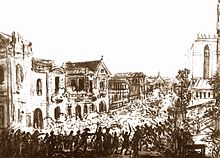Młodziejowski Palace
| Młodziejowski | ||
|---|---|---|
|
Front facade |
||
| Creation time : | 1669 | |
| Castle type : | palace | |
| Conservation status: | Reconstructed | |
| Place: | Warsaw | |
| Geographical location | 52 ° 14 '50.2 " N , 21 ° 0' 38.4" E | |
|
|
||
The Młodziejowski Palace , which is also called the Bidziński, Morsztyn or Igelström Palace after its various owners and residents , is located in Warsaw's inner city district, just outside the old town walls .
location
The palace is located at 10 Miodowa Street , its former courtyard at the back opens to the 7 Podwale Street, which runs parallel to it . The smaller Szaniawski Palace is adjacent to the east . Opposite the main courtyard on Miodowa flows into the ulica Kapucyńska , which today leads to the Trasa WZ expressway, which has been laid down here . Diagonally across the street at Ulica Miodowa 13 (or at Kapucyńskiego 4 ) is a small monastery complex of the Capuchin Order with the associated Church of the Transfiguration of Christ (Polish: Kościoł Przemienienia Pańskiego ).
history
There was already a wooden manor house here in the second half of the 17th century. In 1669 Stanisław Morsztyn owned the estate. Later it belonged to the voivode from Sandomierz , Stefan Bidziński, who presumably had this manor house replaced with a brick, palatial building. An inventory list from 1705 in the Stockholm National Museum shows that the two-storey building at that time was in the late Baroque style and had a mansard roof . Towards the Podwale there were already outbuildings at the rear. The entrance on this rear side ( accessible from the Podwale ) was in a central projectile with a high triangular gable. At Miodowa, the more elegant façade had a central and two corner projections, also crowned with gables. There was a geometrically designed green space between the facade and Miodowa .
Grand Chancellor Andrzej Młodziejowski
With the death of Bidziński, the property probably fell back to the Morsztyn family, and then the Wodziński and Massalski families were owners. In 1766 the palace was sold to Andrzej Młodziejowski by the Bishop of Vilnius , Ignacy Massalski. Under him, the property was rebuilt until 1771 according to a design by Giacomo Fontana . In the direction of the Miodowa , side wings were built as an extension of the former corner projections, which reached the street. A courtyard of honor was created on Miodowa , which was closed off from the street with an arcade and a terrace. According to Łukasz Gołębiowski's remarks from 1827, the bishop liked to eat on this terrace with a tent roof and watch the traffic on Miodowa . Młodziejowski, which was controversial at the time for its corruptibility and excessive lifestyle, died in 1780, three years later Franciszek de la Riviére Załuski bought the palace from the bishop's heirs.
Kościuszko uprising
In the 1790s the commander in chief of the Russian army in Poland, Otto Heinrich Igelström, and the Russian ambassador Jakow J. Sievers lived in the palace. During the Warsaw Uprising of 1794 (as part of the Kościuszko Uprising ), the area around the palace was the scene of fierce fighting, which is why the Russian representatives had to flee Warsaw. During the attack led by Jan Kiliński at this point , the palace ensemble was largely destroyed.
In the years 1806 to 1808 it was rebuilt in the classicist style under Count Feliks Potocki according to a design by Friedrich Albert Lessel . Lessel was also responsible for the construction of the new side wings (instead of the previously existing outbuildings) to the Podwale from 1808 to 1811, which created a second courtyard. In 1818 Karol Zeydler-Zborowski acquired the ensemble. The Warszawska Resursa Kupiecka had its headquarters there from around 1820 until it moved to the Mniszech Palace in 1829 . As a result, bookshops and shops were set up in the palace and from the end of the 19th century the building served only as a tenement house.
World War II and post-war period
At the beginning of the war , the palace, which was no longer impressive at the time, burned down 85% after being hit by bombs. The reconstruction was based on a design by Borys von Zinserling and was completed in 1957. Zinserling roughly restored the condition after the Fontana conversion, plus the Lessel wing to the Podwale , but without the arcade on Miodowa .
After the war, the publishing house Wydawnictwo Naukowe PWN moved into the building. In 2006 the estate in an auction for 34 million was zloty to the company WWG Management sold. The new owner announced that he wanted to divide the building into 36 apartments, each with an area of around 125 square meters. A two-storey parking garage was to be built under the courtyard; Corridors and stairwells should be renovated in the style of the 18th century. The plan was for the first tenants to move into the converted property in 2010.
At the turn of 2011/2012, the German IVG real estate fund bought the building at a price of around 22.4 million euros.
References and comments
- ↑ Stanisław Morsztyn († 1725) was a Polish officer, politician, poet and voivode of Mazovia and castellan of Czersk
- ^ Stefan Bidziński (approx. 1630–1704) was a Polish officer and voivod
- ↑ Andrzej Mikołaj Stanisław Kostka Młodziejowski (1717–1780) was a Polish bishop and great crown chancellor
- ↑ Łukasz Gołębiowski (1773-1849) was a Polish ethnographer and librarian
- ^ Friedrich Albert Lessel (Polish: Fryderyk Albert Lessel, 1767–1822) was a Saxon-Polish architect at the Polish royal court
- ↑ according to A list of war damage in Warsaw (PDF; 241 kB) p. 25, item 85 (in Polish)
- ^ Borys von Zinserling (1889–1961) was an architect and teacher at the Politechnika Warszawska
- ↑ according to Article Apartamentowiec w pałacu po przejściach ( Memento of the original from September 28, 2007 in the Internet Archive ) Info: The archive link has been inserted automatically and has not yet been checked. Please check the original and archive link according to the instructions and then remove this notice. in BiznesPolska.pl , based on a report from Gazeta Wyborcza dated August 11, 2006 (in Polish)
- ↑ according to Adam Zdrodowski, IVG acquires Młodziejowski Palace in central Warsaw in the weekly newspaper Warsaw Business Journal from 9-15 . January 2012 (1/2012), p. 16
See also
Web links
- Information with a historical picture of the palace from 1939 at Warszawa1939.pl (in Polish)
- Brief historical outline of the palace on the website of user PWN
literature
- Julius A. Chroscicki and Andrzej Rottermund: Architectural Atlas of Warsaw , 1st edition, Arkady, Warsaw 1978, p. 170
- Tadeusz S. Jaroszewski: Palaces and Residences in Warsaw , Interpress Publishing, ISBN 83-223-2049-3 , Warsaw 1985, p. 88ff.




